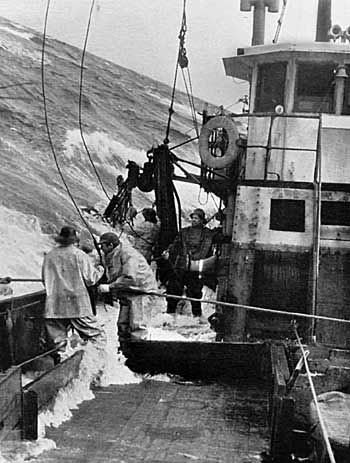Sectors Bumped To 2010
by Laurie Schreiber
|
PROVIDENCE, R.I. – The New England Fishery Management Council decided to put off the implementation date for sector management to May 2010, from May 2009. NEFMC said there just wasn’t enough time to get sectors up and running by next year.
The sign-in date for 2009 implementation would have been by this June. A 2010 date means fishermen will have until June 2009 to sign up for a sector.
“We ought to be upfront with the industry,” said NEFMC member Rip Cunningham. “The reality is, NMFS told us it’s not going to be until 2010. Let’s recognize that fact. Let’s change the schedule.”
Rodney Avila also agreed: “I think people are just assembling at the bus station and the bus hasn’t even been built yet.” “I’m less and less convinced that we’re going to be able to pull it off with any credibility for the industry” for 2009, agreed Terry Stockwell of the Maine Department of Marine Resources.
Sally McGee opposed the change to 2010. McGee said it should be left up to fishermen as to whether they want to sign in this year. Waiting another year, she said, would force fishermen to continue operations under the increasingly stringent days-at-sea program. Some sectors may have coalesced enough that fishermen are ready to take the chance, she said. “It’s backwards. It’s a horrible course of decisions that people have to make without information,” McGee said. “But if people want to take that risk, who are we to say, ‘No, you can’t take that risk.’”
But fishermen themselves agreed the management strategy should be delayed until 2010. “I don’t see that sectors are going to be a great way to go, at least not the way it is now,” said Mike Love. “But if you want to do sectors, wait until 2010 and do it right and not risk it and do a nightmare.”
Vito Giacalone of the Northeast Seafood Coalition said his organization wholeheartedly supports sectors, but agreed the 2009 schedule was unworkable.
continue
|

The delay in sector plans means more ground fishermen will be forced out. “When we were working on sectors we said there should be no more than 20% ownership. With days at sea as a baseline some could monopolize the resource. This is a public resource and should be spread among the public, not handed out to a few people.” —Gary Libby, Midcoast Fishermen’s Association. Kosti Rouhamma photo |
|
|
|
|
Moody's Tower
by Mike Crowe
|
At the eastern end of Congress Street in Portland stands the last of what 200 years ago was a high tech marine communications system. In 1807 the Portland Observatory was state of the art. Although it was not the first built, it is the last standing signalizing tower built along the east coast of the United States at the turn of the 19th century. Seeing the Observatory for the first time these days, and not knowing what it is, with it’s fresh coat of brick red and gray paint demands a double take. The wood shingled octagonal lighthouse-like tower is 85 feet tall, hard against a downtown sidewalk, a mile from a deep-water harbor and looking old and brand new. Now surrounded with one, two and three story, single and multi-family homes, when built it stood alone in a field over looking Portland Harbor.
The story of how the tower got there, what it was built to do, and how it lasted so long goes back to 1807. But the roots of the story likely go back further to 1799, and an incident off the island of Guadaloupe, in the Caribbean.
That part of the story begins with Lemuel Moody. Born in June of 1767, the son of a Portland merchant, Moody joined the U.S. Navy at age thirteen during the American Revolution. He rose through the ranks, became a merchant mariner and captain of the schooner Betsy. A lot of the trade at the time was among east coast American ports, the Caribbean, and South America. In 1799, returning to Portland from South America with a cargo of coffee, molasses and cotton, the Betsy was captured by a French privateer on April 20th, ten days out of Surinam. France and the 10 year-old United States were on the brink of war at the time. The Betsy and cargo were taken as a prize. Moody and the crew were imprisoned on the island of Guadaloupe. At the end of May, Moody was released. He got his ship back, but the cargo had been sold. He found his way back to Portland in July.
continue
|
| The last of the "signalizing towers" built along the east coast of the United States in the early 1800's. Built in 1807, the timber framed, wood shingled tower stood alone in the field that was the top of Munjoy Hill in Portland. Fishermen's Voice photo |
|
|

